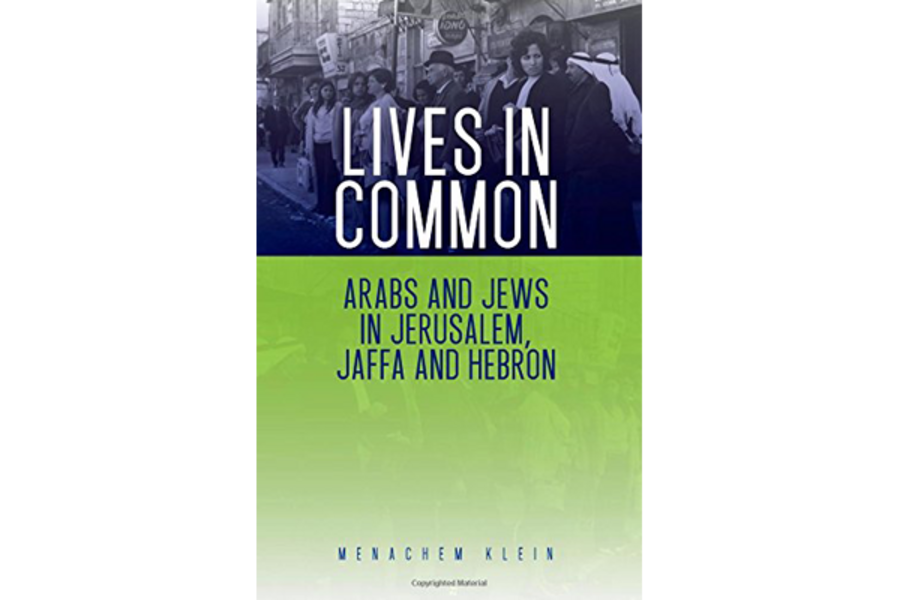'Lives in Common' recalls a not-too-distant time when Arabs and Jews lived as neighbors
Loading...
Projecting the Palestinian-Israeli conflict's intensity and seeming intractability today onto the past, many people assume that enmity has been at the fore of relations for centuries. But in Lives in Common, the dovish Israeli politicial scientist Menachem Klein reclaims a time – only about a century ago – when the interaction was characterized by a good deal of civility, respect, and a shared identity between Arab and Jew in Palestine.
The book, published last month by Oxford University Press, analyses the history of the conflict from bottom up, focusing on the daily interactions of Arab and Jew in Jerusalem, Jaffa, and Hebron beginning in the late 19th and early 20th centuries and extending to the present day. Taking a new and original approach, Klein draws heavily on the diaries and memoirs of ordinary people, elevating his book beyond the usual leader-based perspectives or histories emanating from official documents.
His touching-off point is that before nationalism – both Jewish and Arab – made the words Arab and Jew mutually exclusive, there were people who thought of themselves as ''Arab Jews,'' just as today there are American Jews. Lifestyle, language, culture, and shared attachment to place created a common identity with Muslims that was expressed in every day life, Klein posits. In other words, there were lives in common.The author shows how Jews and Arabs lived in the same courtyards, participated in each other's religious festivals, watched over each other's children, and worked together in charitable and public welfare organizations.
He traces how far we are from that situation today and how we got there, covering all the turning points in the conflict (1929, 1936, 1948, 1967, 2000) and their impact on the relations of ordinary people. Klein, a leading force behind the 2003 Geneva Accord – a non-governmental peace agreement with a group of Palestinians – is clearly someone who looks for common ground. Although he concedes that common identity is a thing of the past never to return, his prose raises the proposition that by injecting mutual consideration, things can be better because they once were better.
In one particularly moving chapter, Klein explores the encounters after the 1967 war between Palestinians visiting their lost family homes in Jerusalem and Jaffa and the Israeli owners who meet them with reactions ranging from denial and derision to understanding. George Bisharat, a law professor at Hastings College in San Francisco was restricted to the foyer of his father's old house in Jerusalem in 1977 and prevented from seeing the rest of it by its defensive Israeli owner, retired supreme court justice Zvi Berenson. But Serene Hussayni Shahid witnessed her mother and the Jewish woman who lived in her former house strike up a rapport when she visited in 1972. Klein shows how wrenching it is for the Palestinians to find the home where they or their parents grew up – and which they still feel they rightfully own – changed beyond recognition.
At times, Klein takes author's license to go into first person to make a point. For example in describing the start of the Six Day War, he recalls what it was like being a 15-year-old boy in a Jerusalem bomb shelter with his mother, a survivor of Auschwitz. He wonders if, during those frightening moments when it felt like Israel faced a mortal threat, his mother doubted her belief that the country was a safe haven against another Holocaust.
The book covers a lot of ground and is not always a page turner. But the bottom-up approach and Klein's human touch keep it compelling. It is also extremely useful for understanding current events such as the recent settlement of more Jews in Silwan, an Arab neighborhood of Jerusalem and the tensions around the al-Aksa mosque compound, known to Jews as the Temple Mount. Klein argues that Jerusalem today is undergoing the same destructive process that Hebron underwent with the establishment of settler enclaves in the 1980s.
Right wing Israelis and their supporters will take issue with that designation and with the book's sensitive treatment of Palestinians. And for those entrenched in the conflict, the very idea that Arabs and Jews once had a common identity may be hard to swallow. Klein's prescription for mitigating the conflict – respect, consideration, and equality – could be attacked as naïve. But coming at the close of a book that is a significant achievement in scholarship and humanism it deserves to be taken seriously. Gauging the diverse interactions between Palestinian exiles and Israeli homeowners, Klein muses: ''Wherever human beings are considerate of each other when they meet, there is a possibility of healing even wounds like those incurred by the refugees of 1948 and 1967.''
Ben Lynfield is a Monitor correspondent based in Jerusalem.






